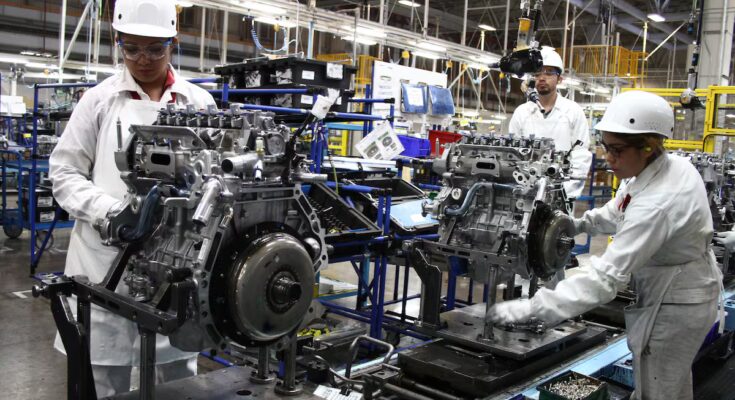Honda, Japan’s second-largest automaker, will slow down in Mexico in the face of the global semiconductor shortage crisis. The assembly company, with plants in the states of Guanajuato and Guadalajara, recognized an “intermittency in the critical semiconductor supply chain.” The shortage of these crucial materials in the manufacture of its vehicles has led to interruptions and adaptations in production at the Celaya plant (Guanajuato). They include temporary reductions or suspensions of production, the company said in writing, and “began in late October and will continue through the month of November.”
Honda Mexico blamed the production problems on the geopolitical dispute affecting the global auto industry. The assembly company, based in Mexico since 1985, is confident that its production will gradually normalize and has assured that Honda partners will continue to work in the company’s factories. The Japanese company declined to provide further details on the decline in its production at Celaya. The Honda plant in Celaya (Guanajuato) is the central point of production of the HR-V SUV. This factory has a production capacity of 200,000 units per year.
Honda’s arrest in Mexico stems from the fight over its supplier Nexperia, a manufacturer based in the Netherlands but with Chinese capital. The Dutch government took control of this company last month, citing concerns about its governance. In retaliation, Beijing blocked exports of Nexperia chips and after this decision a semiconductor supply problem arose that put the global automotive industry in check. After weeks of uncertainty, this Friday some agencies reported that shipments of Nexperia chips from China have already resumed.
Rogelio Garza, president of the Mexican Automobile Industry Association (AMIA), assures that Honda’s semiconductor shortage is a temporary problem, which has only hurt the manufacturer. “So far it is the only company in Mexico to have this problem; no one has told me of our producers who might have a similar problem, let’s hope we don’t have it,” he says.
The industry spokesperson admits that Mexico does not yet produce these types of semiconductors and although there are already initiatives in the country and in North America to develop these types of components and stop depending on factories in Asia, it will take more than four years to realize them. “In Mexico there is a major plan to build a semiconductor plant. It is quite appropriate to think of not having such a high dependence on Asia, which could block production, but they are not immediate plans, they are medium term, between four and five years,” he says.
The shortage of these latest generation components risks hitting a sector already violated by the US tariff wall. Since last April, manufacturers in the Latin American country have paid a tariff of less than 25% on vehicles sent to the neighboring northern country. Although under the protection of the USMCA, Mexican companies have received a discount, depending on the American content of each vehicle, the new tariff agreement represents a barrier to accessing their main market. Added to these taxes are the taxes that came into force on November 1, equal to 25% for exports of heavy trucks and 10% for buses.
Trump has shaken the foundations of the global auto industry with his tariffs and Mexico is no stranger to the impact, with production and exports falling. In October, light vehicle production in the country stood at 367,870 units, an annual decline of 3.7%, the first for an October since 2021. On the other hand, vehicle exports fell by 5.4% in October year-on-year, from 332,356 vehicles to just 314,227 units, according to data from the National Institute of Statistics and Geography (Inegi). Despite the tariff wall, the United States continues to be the top destination for auto shipments from Mexico, with a 78.7% share.
Within this data, Honda production in Mexico decreased by 13.3% in the first ten months of the year, from 166,683 vehicles to 144,452. The Japanese automaker was the third manufacturer with the largest drop in production, surpassed only by Volkswagen (-16.3%) and Mazda (-13.8%). In terms of exports, the company has also seen its international sales decline by 13% this year, according to data reported by Inegi.
The AMIA president acknowledges that since tariffs were raised on Mexican shipowners in April, they have sought through the government and directly in Washington to eliminate those taxes, an effort that has yet to bear fruit. “The tariff impact is currently being absorbed by companies, they have not yet passed it on to a significant extent to consumers, but this cannot continue like this, obviously all assembly companies are in a process of reorganizing their production,” he warns.
Looking ahead to the USMCA review next year, Garza acknowledges that it will be a difficult and complicated review in the United States. The most sensitive issues will concern the percentage of source content and the rapid response mechanism of the work. However, the industrialist is confident that the North American trade agreement, a cornerstone of automotive exports, will survive beyond July 2026. “We all agree that USMCA must move forward, the agreement is good for everyone,” concludes the automotive spokesperson.
With more than 3.9 million cars produced each year, Mexico is the seventh largest automotive producer in the world. Of these figures, more than 80% of production goes abroad, turning the industry into an export sector stronghold. Last year, the Latin American country shipped 2.9 million finished vehicles to the United States, worth $78.5 billion. If you add car parts and engines, the value in foreign currency amounts, according to official data, to more than 182,000 million dollars. The sector, which has accelerated strongly in recent years, will now face the challenges of an international trade war.



